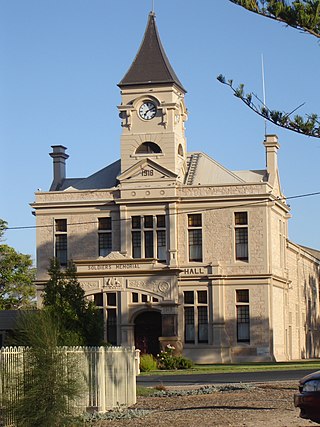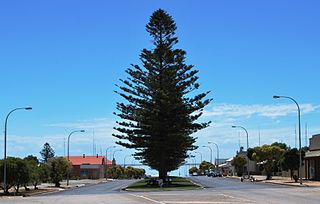
Dhilba Guuranda–Innes National Park, formerly Innes National Park, is an IUCN-designated protected area in the Australian state of South Australia located on the southwest tip of Yorke Peninsula about 300 kilometres (190 mi) west of the state capital of Adelaide. It is a popular destination for camping, bushwalking, fishing, surfing and scuba diving.

The Yorke Peninsula, known as Guuranda by the original inhabitants, the Narungga people, is a peninsula located northwest and west of Adelaide in South Australia, between Spencer Gulf on the west and Gulf St Vincent on the east. The peninsula is separated from Kangaroo Island to the south by Investigator Strait.

Iron-hulled sailing ships represented the final evolution of sailing ships at the end of the age of sail. They were built to carry bulk cargo for long distances in the nineteenth and early twentieth centuries. They were the largest of merchant sailing ships, with three to five masts and square sails, as well as other sail plans. They carried lumber, guano, grain or ore between continents. Later examples had steel hulls. They are sometimes referred to as "windjammers" or "tall ships". Several survive, variously operating as school ships, museum ships, restaurant ships, and cruise ships.

Wallaroo is a port town on the western side of Yorke Peninsula in South Australia, 160 kilometres (100 mi) northwest of Adelaide. It is one of the three Copper Triangle towns famed for their historic shared copper mining industry, and known together as "Little Cornwall", the other two being Kadina, about 8 kilometres (5 mi) to the east, and Moonta, about 18 kilometres (11 mi) south. In 2016, Wallaroo had a population of 3,988 according to the census held.

Passat is a German four-masted steel barque and one of the Flying P-Liners, the famous sailing ships of the German shipping company F. Laeisz. She is one of the last surviving windjammers.

Pommern, formerly Mneme (1903–1908), is an iron-hulled sailing ship. It is a four-masted barque that was built in 1903 at the J. Reid & Co shipyard in Glasgow, Scotland.

Ardrossan is a town in the Australian state of South Australia located on the eastern coast of the Yorke Peninsula, about 150 kilometres (93 mi) by road from the Adelaide city centre. It is notable for its deepwater shipping port and its towering coastal cliffs of red clay.

Port Victoria is a town on the west coast of Yorke Peninsula in the Australian state of South Australia.

Maitland is a town on the Yorke Peninsula in South Australia. By road, it is 168 km (104 mi) west of Adelaide, 164 km (102 mi) south of Port Pirie and 46 km (29 mi) north of Minlaton. The town lies in the traditional lands of the Narungga, whose name for the district is Maggiwarda.

Investigator Strait is a body of water in South Australia lying between the Yorke Peninsula, on the Australian mainland, and Kangaroo Island. It was named by Matthew Flinders after his ship, HMS Investigator, on his voyage of 1801–1802. It is bordered by the Gulf St Vincent in the northeast.

The Last Grain Race is a 1956 book by Eric Newby, a travel writer, about his time spent on the four-masted steel barque Moshulu during the vessel's last voyage in the Australian grain trade.

Port Rickaby is a town on the Spencer Gulf coast of Yorke Peninsula in South Australia.

Herzogin Cecilie was a German-built four-mast barque (windjammer), named after German Crown Princess Duchess Cecilie of Mecklenburg-Schwerin (1886–1954), spouse of Crown Prince Wilhelm of Prussia (1882–1951). She sailed under German, French and Finnish flags.

SS Ferret was an iron screw steamship of 460 tons built in Glasgow (Scotland) in 1871 by J & G Thomson, Glasgow.

Grain Race or The Great Grain Race was the informal name for the annual windjammer sailing season generally from South Australia's grain ports on Spencer Gulf to Lizard Point, Cornwall on the southwesternmost coast of the United Kingdom, or to specific ports. A good, fast passage Australia-to-England via Cape Horn was considered anything under 100 days.
Point Pearce, also spelt Point Pierce in the past, is a town in the Australian state of South Australia. The town is located in the Yorke Peninsula Council local government area, 194 kilometres (121 mi) north-west of the state capital, Adelaide.

The Åland Maritime Museum is a museum in Mariehamn in Åland, Finland. It is located in the western part of the town on the sea on Hamngatan, about 1 km (0.62 mi) at the other end of Storagatan. Along with Ålands Museum, it is the most important museum in the islands and a monument to the history of Åland as holder of the world's largest fleet of wooden sailing ships. The foremost exhibit is a four-masted barque named Pommern, built in Glasgow in 1903, which is anchored behind the museum. The museum designed building is built like a ship's prow cutting into the land. It has been called the "kitsch museum of fishing and maritime commerce."

Wardang Island, also known as Waralti is a low-lying 20 km2 island in the Spencer Gulf close to the western coast of the Yorke Peninsula, South Australia. It acts as a natural breakwater, protecting the former grain port of Port Victoria and providing a sheltered anchorage. After European colonisation it was used for the grazing of sheep, for rabbit disease research, was quarried for lime to supply the lead smelter at Port Pirie and is currently leased to the island's traditional owners: the Narungga. The much smaller Goose Island and the other rocks and islets in the Goose Island Conservation Park lie off the northern end. Anyone seeking to visit the island must obtain prior permission from the Point Pearce Community Council.

Hougomont was the name of a four-masted steel barque built in Greenock, Scotland in 1897 by Scotts Shipbuilding & Engineering Co. In 1924 she was purchased by Gustav Erikson's shipping company in Mariehamn, Åland, Finland. She was used for transport and schooling ship for young sailors until 1932 when a squall completely broke her rig on the Southern Ocean and she was sunk as breakwater near the town of Stenhouse Bay in South Australia. ' Hougomont had a crew of 24 men. The name "Hougomont" is derived from Château d'Hougoumont where the Battle of Waterloo was fought. While seaworthy she sailed to Peru, Florida, Canada, Australia, England, Ireland, and Sweden among other destinations. She had two sister ships, Nivelle and Archibald Russell.

Admiral Karpfanger was a German four-masted barque that was a cargo ship and sail training ship. She was built near Bremerhaven in 1908 as l'Avenir, which was the name that she bore until 1937. She spent most of her career with the Association Maritime Belge, SA.



















